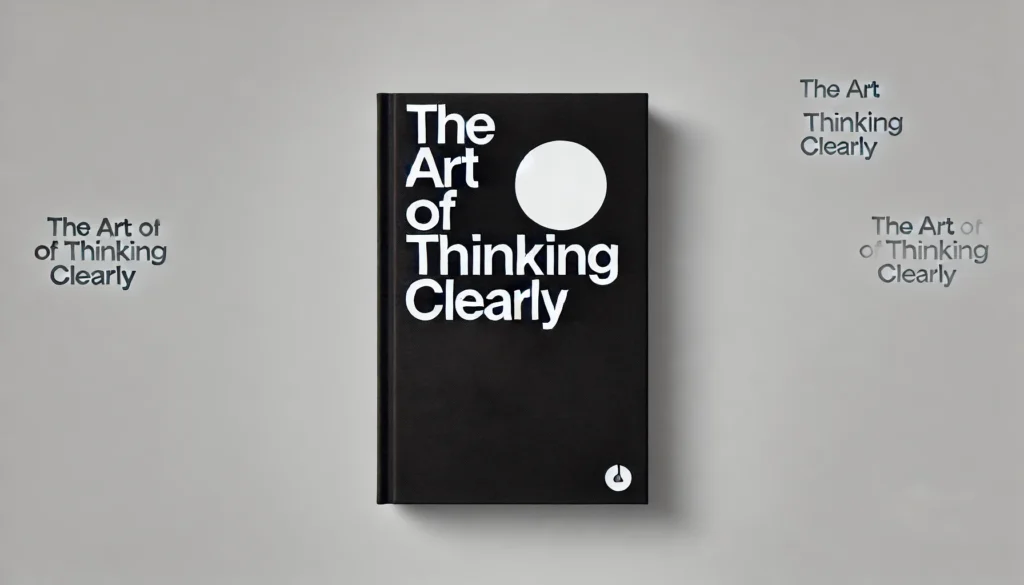Summary of The Art of Thinking Clearly by Rolf Dobelli

What’s in it for me?
Learn to recognize and avoid common cognitive errors that distort your thinking and decision-making.
The Art of Thinking Clearly by Rolf Dobelli is a guide to identifying and overcoming the cognitive biases that often lead to poor decisions. Dobelli explains how our minds are wired to make predictable mistakes in judgment, which can have significant consequences in our personal and professional lives. By becoming aware of these biases, we can train ourselves to think more clearly, make better decisions, and lead more rational lives.
This summary will explore the key ideas presented in the book, focusing on the most common cognitive errors and how to avoid them.
Key Idea 1: The Power of Survivorship Bias
One of the most pervasive cognitive errors is Survivorship Bias. This occurs when we focus on successful people or outcomes while ignoring those who failed. This bias leads to an inflated sense of the probability of success because the failures are often invisible. Dobelli illustrates this with examples from business, where the stories of successful entrepreneurs are celebrated, but the many who fail are forgotten.
To counter survivorship bias, it’s important to actively seek out the stories of those who didn’t make it and understand the reasons behind their failures. By doing so, you gain a more realistic perspective on success and avoid the trap of assuming that following the same path as successful people will automatically lead to the same outcomes.
Key Idea 2: The Danger of Confirmation Bias
Confirmation Bias is the tendency to seek out and interpret information in a way that confirms our pre-existing beliefs. This bias is particularly dangerous because it leads to closed-mindedness and reinforces erroneous beliefs. Dobelli explains that when we fall prey to confirmation bias, we ignore or dismiss evidence that contradicts our views, leading to flawed decision-making.
To avoid confirmation bias, it’s crucial to actively seek out disconfirming evidence and consider alternative perspectives. This requires a conscious effort to question your assumptions and remain open to new information, even when it challenges your beliefs. By doing so, you can develop a more balanced and accurate understanding of the world.
Key Idea 3: The Illusion of Control
The Illusion of Control is the belief that we have more control over events than we actually do. This cognitive bias leads to overconfidence and risky behavior, as we underestimate the role of chance in our lives. Dobelli provides examples from gambling and investing, where people often believe they can influence outcomes that are largely determined by luck.
To mitigate the illusion of control, it’s important to recognize the limits of your influence and to base decisions on probabilities rather than wishful thinking. Acknowledging the role of chance in your life can help you make more rational decisions and avoid the pitfalls of overconfidence.
Key Idea 4: The Sunk Cost Fallacy
The Sunk Cost Fallacy is the tendency to continue investing in a losing proposition because of the time, money, or effort already spent. This bias is driven by a desire to avoid admitting failure and the emotional attachment to past investments. Dobelli warns that clinging to sunk costs can lead to further losses and missed opportunities.
To overcome the sunk cost fallacy, it’s essential to base decisions on future potential rather than past investments. This means being willing to cut your losses and move on when a situation is no longer beneficial, regardless of how much you’ve already invested. By focusing on the future rather than the past, you can make more rational choices and avoid being trapped by sunk costs.
Key Idea 5: The Availability Bias
The Availability Bias is the tendency to judge the likelihood of an event based on how easily examples come to mind. This bias can lead to distorted perceptions of risk, as we overestimate the frequency of dramatic events and underestimate more common but less memorable ones. Dobelli explains that the media often exacerbates this bias by focusing on sensational stories, leading to skewed perceptions of reality.
To counter the availability bias, it’s important to base your judgments on statistical evidence rather than anecdotes or media reports. By seeking out accurate information and considering a wide range of possibilities, you can develop a more realistic understanding of the risks and probabilities involved in your decisions.
Closing Note
If this summary resonated with you, your feedback would be greatly appreciated. Your thoughts help us continue to improve and provide the content you love. See you in the next summary!